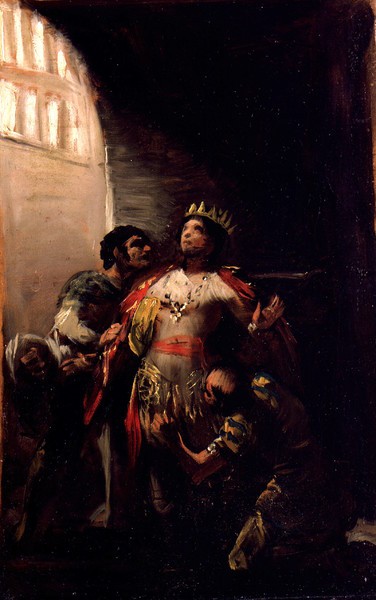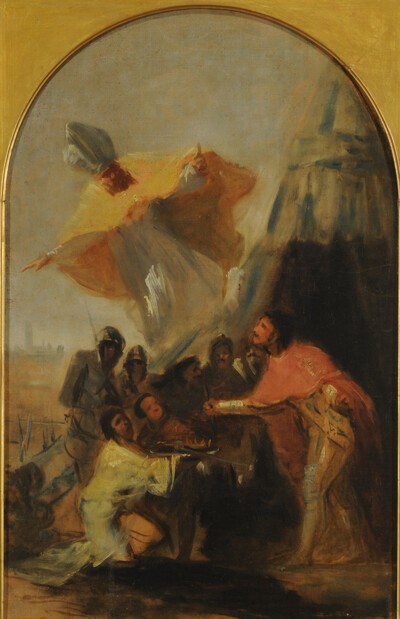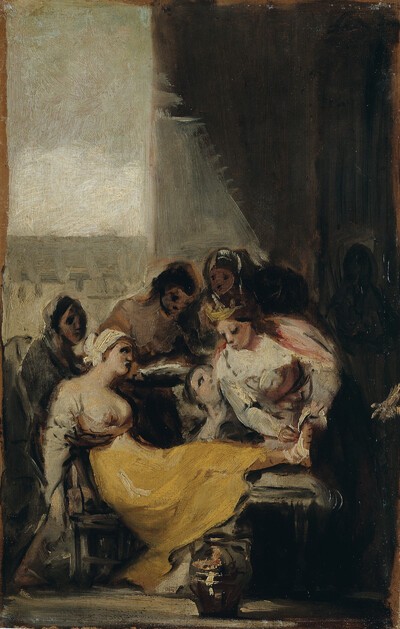- Cronología
- 1800
- Ubicación
- Lázaro Galdiano Museum, Madrid, Spain
- Dimensiones
- 33 x 23 cm
- Técnica y soporte
- Oil on canvas
- Reconocimiento de la autoría de Goya
- Undisputed work
- Titular
- Lázaro Galdiano Foundation
- Ficha: realización/revisión
- 31 Jan 2010 / 13 Jun 2023
- Inventario
- (2017)
See Apparition of Saint Isidore to Saint Ferdinand III. This sketch belonged to Martín Zapater, and was inherited by his grand-nephew Francisco Zapater y Gómez. Clemente Velasco bought the sketch, selling it in 1930 to José Lázaro Galdiano. It was entrusted to the museum bearing his name in 1951.
The painting corresponding to this sketch was located on the Epistle side of the church. The story depicted is that of the Visigoth king, son of Leovigild, proclaimed governor of Seville by his father only to later be condemned by him when he found out that his son has converted to Christianity. Leovigild imprisoned his son, and when he could not persuade him to renounce his faith he ordered for him to be beheaded. The place in Seville where these events took place is the site of the church raised in his name.
It is the most finished sketch of the three. The converted Visigoth king is shown in the gloom of the prison, still dressed in elegant clothing. He is surrounded by three jailors who try to humiliate him and provoke him into renouncing his faith. The king resists, maintaining his dignity and pride and looking heavenwards. He is illuminated by a light which filters through the bars of the cell, creating a strong chiaroscuro between the two sides of the composition. The sparkling highlights of the saint's clothing and his expression of suffering are striking, even though this is only a preliminary study.
-
Goya 1900Ministerio de Instrucción Pública and Bellas ArtesMadrid1900consultant editors Aureliano de Beruete, Alejandro Ferrant, Marqués de Pidal and Ricardo Velázquez. May 1900cat. 31: Clemente Velasco
-
Pinturas de GoyaMuseo Nacional del PradoMadrid1928consultant editor Fernando Álvarez de Sotomayor. From Apri to -May 1928cat. 31/87: Clemente Velasco
-
Goya (1746 – 1828)Galleria Internazionale d’Arte Moderna di Ca’PesaroVenecia1989consultant editor Antonio Fortún Paesa. From May 7th to July 4th 1989cat. 31
-
GoyaLa Lonja, Torreón Fortea y Museo Pablo GargalloZaragoza1992consultant editor Julián Gállegocat. 32
-
Goya. El Capricho y la Invención. Cuadros de gabinete, bocetos y miniaturasMuseo Nacional del PradoMadrid1993from November 18th 1993 to February 15th 1994. Exhibited also at the Royal Academy of Arts, London, March 18th to June 12th 1994 and The Art Institute of Chicago, Chicago, July 16th to October 16th 1994, consultant editors Manuela B. Mena Marqués and Juliet Wilson-Bareaucat. 58
-
Realidad e imagen. Goya 1746 – 1828Museo de ZaragozaZaragoza1996consultant editor Federico Torralba Soriano. From October 3th to December 1st 1996cat. 38
-
L'œuvre peint de Goya. 4 volsParís1928-1950p. 144, cat. 101
-
Bosquejo histórico de don José DuasoAnales del Instituto de Estudios Madrileños1968pp. 358-365
-
Vie et ouvre de Francisco de GoyaParísOffice du livre1970pp. 165, 194, cat. 740
-
BarcelonaPolígrafa1970vol. I, p. 319, cat. 461
-
L’opera pittorica completa di GoyaMilanRizzoli1974p. 115, cat. 393
-
Goya. El capricho y la invención. Cuadros de gabinete, bocetos y miniaturasMadridMuseo del Prado1993pp. 241, 242, 368, cat. 58 y p. 245 (il.
-
Francisco de Goya, 4 vols.ZaragozaCaja de Ahorros de Zaragoza, Aragón y Rioja1980-1982vol. III, p. 127.
-
Goya y Aragón. Familia, amistades y encargos artísticoscol. Col. Mariano de Pano y RuataZaragozaCaja de Ahorros de la Inmaculada de Aragón1995pp. 184-190 y p. 187 (il.)
-
Realidad e imagen. Goya 1746 – 1828MadridGobierno de Aragón y Electa España1996pp. 122-124, cat. 38 y pp. 123, 125 (ils


